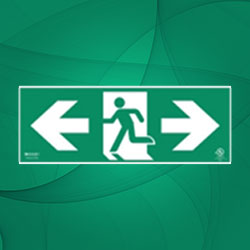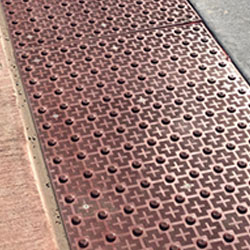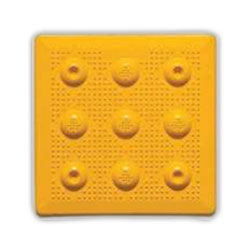

































































































































In public realm design, curb ramps serve a vital yet often overlooked role in fostering accessibility. Providing a smooth transition between the sidewalk and street, proper curb ramp design marks the first step toward creating more navigable, connected, and inclusive communities.
This blog explores the significance of thoughtfully designed curb ramps. We'll cover curb ramp benefits, standards, best practices, common issues, and solutions for constructing accessible, compliant ramps with detectable warnings. Read on for a comprehensive look at how quality curb ramps form the foundation for improved community mobility.
For pedestrians using mobility devices such as wheelchairs, curb ramps provide the crucial link between the sidewalk and the street. They allow safe passage for those who cannot navigate standard curbs. Without compliant curb ramps, individuals with disabilities face significant barriers traversing the urban landscape.
Well-designed curb ramps also benefit many other groups, including:
Seniors with mobility impairments
Parents with strollers
Delivery workers moving goods
Cyclists entering the roadway
Pedestrians with temporary injuries
By promoting connectivity between pedestrian and vehicular zones, curb ramps enable people of all ages and abilities to access communities. They also improve walkability and active transportation. Simply put, thoughtfully engineered curb ramps provide significant social, environmental, and economic benefits in our communities.
Curb ramps must adhere to established design standards and regulations to provide consistent accessible cues. Key codes and guidelines for curb ramps in Canada include:
Accessibility for Ontarians with Disabilities Act (AODA)
CSA B651-18 - Accessible design for the built environment
Ontario Building Code
Canadian Standards Association (CSA)
Global Alliance on Accessible Technologies and Environments (GAATES)
National Building Code of Canada
These standards define important curb ramp specifications like:
Maximum slopes and cross slopes
Minimum clear width
Mandatory landings at turns
Required handrails and edge protection
Detectable warning surface requirements
By consulting relevant codes and working with experienced accessibility specialists, planners can develop optimally compliant and navigable curb ramp designs tailored to specific community needs.
Universal design principles emphasize the importance of developing holistically accessible and connected pedestrian networks. Here are some best practice strategies for achieving excellent curb ramp design:
Provide ramps at all intersections and crossing points
Ensure detectable warnings extend the full ramp width
Confirm 1:50 max cross slope and 1:12 max running slope
Include required 1.2 m x 1.2 m landings at turns
Verify adequate top/bottom ramp landings
Eliminate uneven transitions or gaps between surfaces
Select durable, slip-resistant surface materials
Validate ramp components do not impede drainage
Facilitate integrated wheelchair access where possible
Incorporate suitable handrails for support and guidance
Maintain clear sightlines for visibility and safety
Well-planned curb ramp networks create cohesive, intuitive access that promotes confident mobility within communities.
Despite existing standards, many curb ramps remain non-compliant and difficult to navigate. Some common issues include:
Excessive slopes beyond permitted ratios
Narrow ramp widths impede maneuverability
Lack of integrated bottom/top landings
Poor drainage causes water pooling
Missing or inadequate detectable warnings
Broken/uneven surfaces causing tripping hazards
Tight turning radii creating challenges for mobility devices
Ramps facing the wrong direction away from crossings
Such deficiencies not only violate code requirements but also create frustrating obstacles limiting access and participation.
Quality-detectable warning systems are essential to constructing fully accessible and compliant curb ramps. Also known as truncated domes, these specialized texture systems:
Provide a tactile cue detectable underfoot and visually contrasting
Alert pedestrians to the transition from sidewalk to street
Indicate the boundary between pedestrian and vehicular zones
Encourage proper crossing position in line with ramps
Meet code requirements for standardized truncated dome size, spacing, and placement
Detectable warnings are a legally required component for accessible curb ramps. However, not all products are created equal. Specifying durable, compliant systems builds long-lasting community access.
As Canada's top accessibility solutions provider, Tactile Solution Canada supplies superior detectable warning products from leading manufacturers like:
Armor Tile® Cast-In-Place Truncated Domes
Access Tile® Surface-Applied Truncated Domes
Advantage Truncated Dome Tactile Systems
Eon® Flexible Rubber Tactile Tiles
Elan Tactile Vitrified Porcelain Pavers
Our extensive range of solutions are:
Custom fabricated in required sizes
Available in multiple high-visibility colors
Manufactured from durable metals, polymers, rubber, porcelain
Slip resistant for Canadian weather conditions
Compliant with CSA B651 and other regulators
Eligible for LEED credits as sustainable materials
Backed by 5+ year product warranties
With customizable modular systems, we can supply the optimal product tailored to your specific curb ramp specifications and community needs.
Curb ramps are invaluable in connecting communities. Well-engineered detectable warnings complete the access path, allowing people of all abilities to traverse the built environment confidently. With ADA/CSA-compliant systems available in various durable materials and high-visibility colors, specifiers can select optimal solutions to complement the surrounding landscape.
Contact the experts at Tactile Solution Canada today for all your accessible paving needs. Let's work together to create more navigable, vibrant, and inclusive communities across Canada.
Curb ramps enable access for wheelchairs while also benefiting seniors, parents, cyclists, and pedestrians with temporary mobility limitations.
The AODA, Ontario Building Code, CSA B651, National Building Code, and GAATES guidelines apply to curb ramps.
Detectable warnings must be integrated along the full width at the bottom of curb ramps where they meet the street.
Follow best practices such as proper slopes, widths, and landings. Specify high-quality detectable warning systems.
Tactile Solution Canada supplies superior ADA/CSA-compliant tactile warning systems from leading manufacturers.
